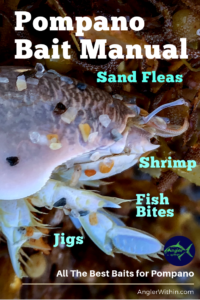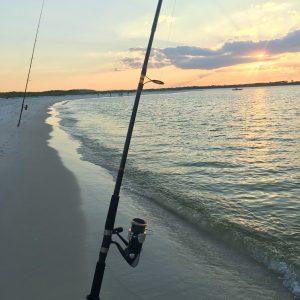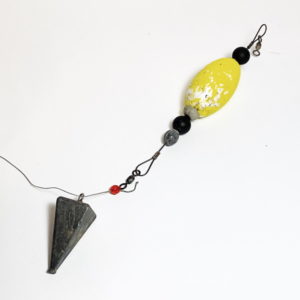If you came searching for a complete list of ALL the best baits for pompano, then you came to the right spot! So that I don’t waste your time, you can find the full list just below.
If you would like to know more about each one and how to obtain them, then keep reading. At the end, I’ll lay out my own personal preferences and why.
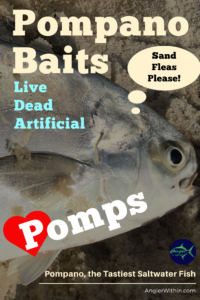
Best Baits for Pompano
Live Baits
- Sand Fleas (Mole Crabs)
- Shrimp
- Ghost Shrimp
- Fiddler Crabs
Dead Baits
- Fresh Dead Shrimp
- Frozen (and blanched) Sand Fleas
Artificial Baits
- Fish Bites
- Goofy (Banana) Jigs
- NyLure Pompano Jigs
Honorable Mentions
Live Baits
- Coquina and Other Clams
- Other Small Crabs
Dead Baits
- Salted Clams
- Frozen Shrimp
- Cut Squid
Artificial Baits
- Crappie Jigs
- Artificial Flies (for Fly Fishing)
- Bucktail Jigs
- Soft Plastics
Introduction
To begin, I would like to quickly explain what the “swash” zone is and why it’s relevant to the discussion. In my own layman’s terms, “swash zone” refers to that area of the beach where the ocean’s waves lap over onto the sand before retreating back to the normal water’s edge. It is in this zone that two of the pompano’s favorite baits lurk – Sand Fleas and Coquina Clams.
I remember the first time I came across a mass of these clams on a Florida beach as I was amazed at the number of them and the variety of colors. To this day, I still don’t think I have seen so many as I saw that day, as there seemed to be thousands. At the time I had no idea those little guys were a staple of the pompano’s diet and that I had stumbled upon a great spot to fish for pompano. But, before we get to the clams, let’s talk about what is widely considered to be the best bait for Pompano – Sand Fleas!
The Best *LIVE* Baits for Pompano
1. Sand Fleas
Live bait is almost always your best option for pompano, and of the live bait options, sand fleas are the reigning king. From what I understand, sand fleas are what most of the commercial pompano fishermen use, so that should clue us in to their effectiveness.
They are typically available during times when sizable pompano are running the beaches. After all, this abundance of sand fleas is a major reason why you would find pompano hanging around any given beach. However, that doesn’t mean they are always easy to find when you need them. That is one of the reasons this article doesn’t just stop after listing sand fleas.
With that said, sand fleas are without a doubt my favorite pompano bait, and best of all they are FREE!
What’s in a name? #MoleCrabs—also called #SandFleas or #SandFiddlers —are true #crabs, despite a lack of pincers! pic.twitter.com/BlDA8U27Be
— Cape Hatteras National Seashore (@CapeHatterasNPS) October 22, 2014
I like to rig my sand fleas, as well as most other live or dead baits, on a 2-hook pompano rig. Sometimes I use store-bought rigs with the little floats but I’ll also tie my own rigs ahead of time. When I tie my own, I may or may not use floats, beads or swivels in my setup. Sometimes I just tie them with only line and hooks and that seems to work just fine. However, most of the time I do at least include orange beads in my setup so as to mimic the orange eggs from the underside of larger female sand fleas.
See my crude image below for approximate dimensions of an effective pomp rig. The image is not built to scale, and it was tied with over-sized line and tackle for visual purposes. Refer to the written dimensions to see which measurements I actually prefer. Also, don’t use black line! ha ha. I colored up some 60 lb mono to make it easier to see. It seems like everyone has a different preference when it comes to pompano rig dimensions and this is simply my own.

To collect sand fleas, you can actually just scoop them up with your hands if there are a lot of them in the surf. They can’t pinch you or harm you in any way so there is no need to be concerned when grabbing them. Depending on how young you are, that may or may not work well for you. My back doesn’t really allow me to do that comfortably anymore.
The second cheapest, and more effective, option is to buy a metal noodle strainer (colander) from the dollar store and use that to scoop them out of the sand. When fleas are abundant, this can actually work pretty well. But, again, the 40 year old back doesn’t like that option either.
I resisted for a while, but I finally broke down and invested in a sand flea rake and boy was it worth it. A good rake makes it much easier to collect fleas quickly and efficiently. The trade-off is that you do have to carry one additional piece of equipment to the beach. I decided to deal with that small hassle for the amount of time it saves when gathering bait. Besides saving time and backache, another advantage of the rake is that you can probe deeper water on those days when fleas are hard to come by. Sometimes, using your rake, you can find enough of them hiding in the deeper areas of the surf zone to get you by for the day. This is the sand flea rake I purchased from Amazon several seasons ago, and I use it every time I head to the beach for pompano. I like a medium sized rake like this one since it’s plenty big enough, but not so big that it’s heavy and cumbersome to carry. This is a much better rake than you will find in the local Wally World.
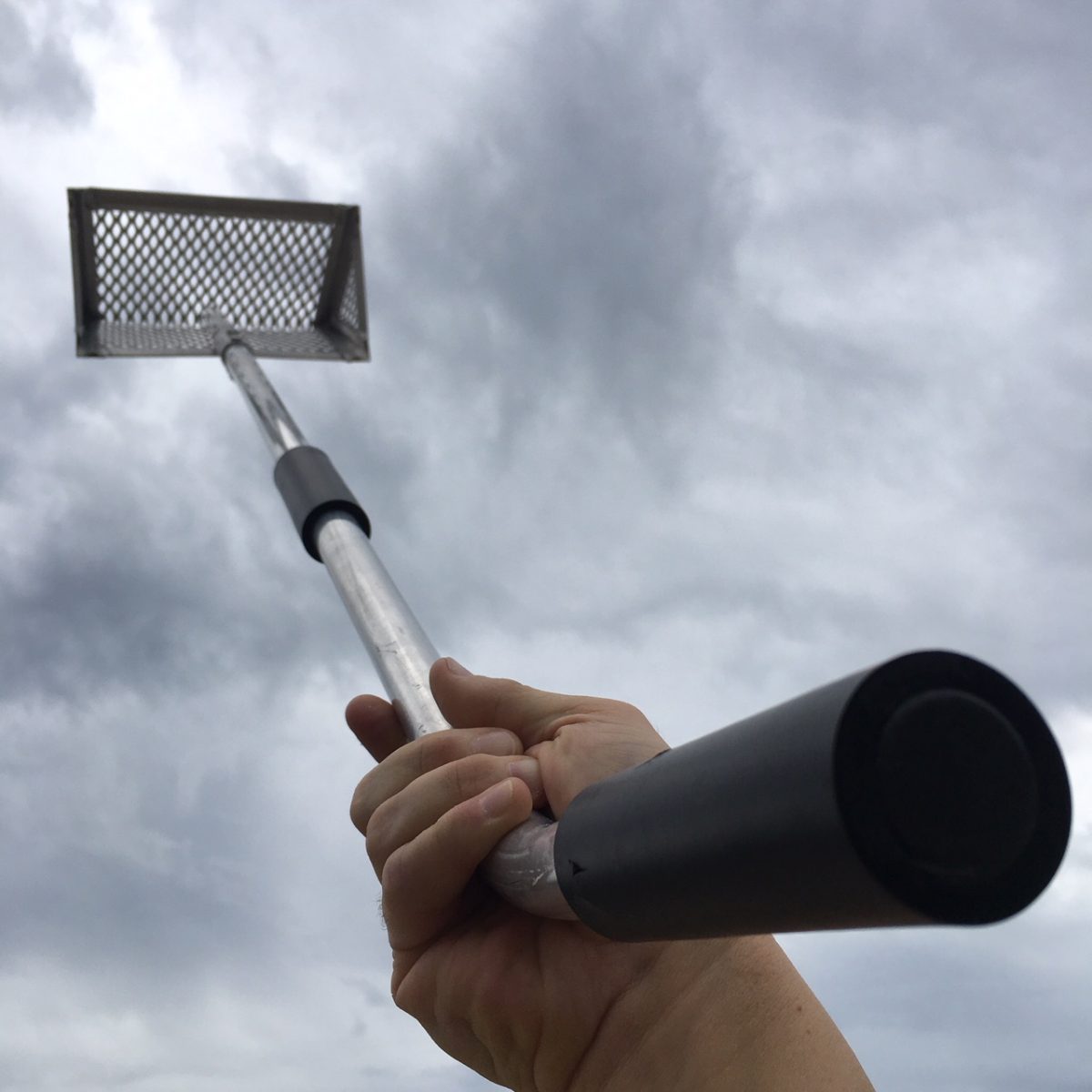

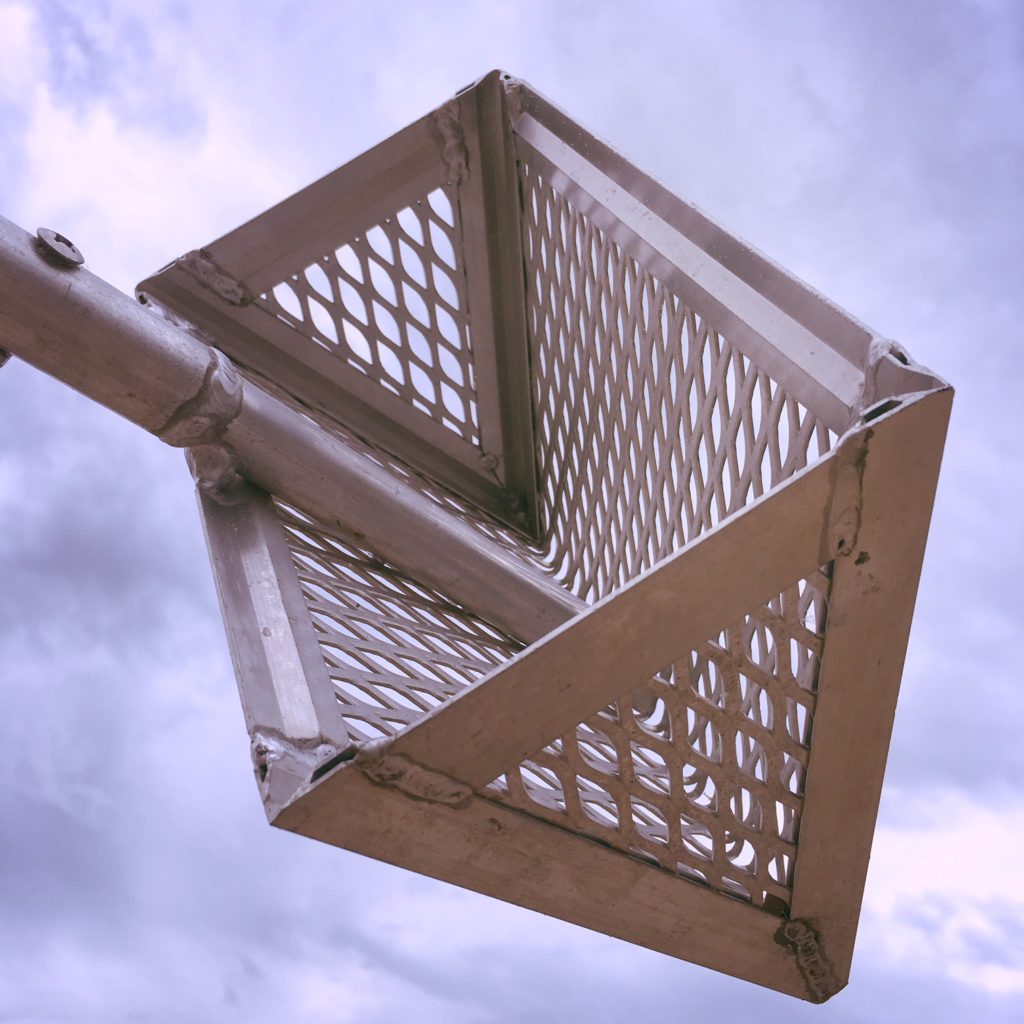

If you need to save weight, and bulk, because you are going to be making a long trek on foot to your fishing spot, it’s hard to beat a dirt-cheap colander from the dollar store!
When there just don’t seem to be any sand fleas around and you are having difficulty finding any on a particular stretch of beach, it could be because that beach has recently undergone a “re-nourishment”. Basically, that means the local government dumped a bunch of new sand on the beach to attract tourists. When they do this, it devastates the coquina clam and sand flea populations in that area for a while. If you find this to be the case, you might do better to move to a different beach that has more bait.
Live Shrimp
Shrimp are almost always a good option no matter what species of fish you are targeting. Everything that swims out there will eat a shrimp, but of course that brings with it some downsides. It can be impossible, at times, to keep undesirable species away from your shrimp long enough for a pompano to get it. Nevertheless, live shrimp are still a go-to bait and you should include it in your arsenal. For pompano fishing, you will want to use the smallest shrimp that you can find. Unfortunately, small shrimp aren’t always available, so you may have to break them into pieces when they are running too large.
I always purchase my live shrimp from a bait shop but I understand that some people actually catch their own. Since I have never tried that, I don’t have a lot of insight there. But, I did watch some online videos and it does look like it could be a fun nighttime endeavor. I just wanted to mention that was an option.
Just as with sand fleas, when I use live shrimp, I generally rig them onto store-bought or hand-tied pompano rigs. I actually prefer to tie my own rigs, partly because I prefer high quality 1/0 circle hooks as opposed to the larger and lower quality kahle hooks that normally come on store-bought rigs. There is nothing wrong with a kahle hook, they are just not my preference.
Below is a comparison photo of a 1/0 circle hook referenced to a dime. This is about the size hook I usually use for all my live and dead pompano baits.
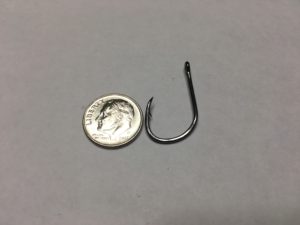
Shrimp can be hooked a variety of ways, but my preference is to hook a live shrimp just under the horn between the eyes and the dark spot. Be careful not to pierce the dark area as that will kill the shrimp in short order. Carefully pierce the shell right under the horn and slowly work your hook through to the other side being careful not to crush the bait. You can also hook a shrimp through the tail which allows for a more natural presentation if you intend to slowly work the bait back to you. When Pompano fishing, I’m casting out a 2-hook Pompano Rig and letting it soak, so I think horn hooking is a more effective option for me.
Keep in mind, when fishing with live shrimp, that they will sling off the hook if you whip your rod too hard, so take it easy. The Pompano aren’t usually that far out where I fish anyway.
Ghost Shrimp
Ghost shrimp make for a great pompano as well as sheepshead bait, but you will have to put in a little work to obtain them. You will need to build or buy a ghost shrimp slurp gun or pump as they are called. You can do so very cheaply for under $20. I attached a Youtube video below on how to do this.
Once you have your gun, you will need to search for their burrows or holes in the sand and stick your gun over the hole and work the pumps action to suck them out. This works best around mud flats with very saturated sand but you can also do this on the beach in the edge of the surf.
I’m not certain that these guys are found everywhere, so you will need to check to see if they are found in your area and are of big enough size to be used as bait. I know they are common along the Alabama and Florida Panhandle coastline.
Many people think ghost shrimp work better than the shrimp purchased at a bait shop.
The idea of free bait always intrigues me, so I look forward to trying these for myself which I have yet to do.
Fiddler Crabs
Fiddler crabs are another good bait for pompano. You can catch them yourself or just buy them at most large bait shops. If you decide to catch them yourself, there are many videos on Youtube that will show you how. To hook fiddlers, use the same 1/0 circle hook mentioned above and gently pierce the underside of the crab on one side and come out the hard shell on top. Be careful no to crush the bait so that the crab will stay alive for a short while. The bigger male fiddlers will have a larger claw that you will want to remove.
Clams
Coquina Clams, as discussed above, are prevalent all along Gulf Coast and Atlantic beaches where pompano feed on them regularly. They are found in a wide array of colors as can be seen in the image below, but sometimes there will be a predominant color on a particular stretch of beach. We can use this predominant color to help us decide what color beads to use on our Pompano rigs. You don’t have to use beads, of course, but they do sometimes improve the bite if you use them to match the hatch, so to speak. Orange is always a great bead color as it mimics the orange eggs commonly found on the underside of bigger female sand fleas. Other bead colors can work well too, especially if there are lots of coquina clams around in some color other than orange.
You can use these coquina clams as your actual bait, but you probably don’t want to since they are quite small. Instead, it’s better to use strips of other types of clams in order to mimic the coquina’s. If you can’t find fresh clam, then preserved or salted clams are a good alternative.
CREATURE FEATURE: COQUINA CLAMS
— Padre Island N.S. (@PadreIslandNPS) October 17, 2018
Watch as they use their foot (the small appendage coming out of their shell) to dig themselves back into the sand. #beach #waves #padreislandnationalseashore #padreisland #northpadreisland #nps #usinterior #corpuschristi #southtexas #gulfcoast pic.twitter.com/94MCJkpp1A
Other Crabs
Pretty much any small crab the size of a fiddler crab will work well for pompano. Just be careful not to use a juvenile version of a protected species.
The Best *DEAD* Baits for Pompano
Fresh Dead or Frozen Shrimp
Fresh dead shrimp is definitely one of the best baits for pompano – the key being “FRESH”. Frozen shrimp works OK, but fresh shrimp will outshine frozen every time. Sometimes fresh dead shrimp can even outperform live sand fleas.
A great advantage of dead shrimp, if you are surf fishing, is that you don’t have to go through the hassle of carrying live bait to the beach. Who wants to carry an extra bucket full of water to the beach? I have done it and it is a real pain. Another advantage is that you can break the shrimp up into the perfect sized pieces for your pompano rigs.
You, of course, can purchase dead shrimp at pretty much any coastal tackle shop, but you can also buy fresh dead shrimp at your local supermarket which can sometimes be much more convenient than making a run to the bait store. When buying fresh dead shrimp from the supermarket you can also be pickier about what size you purchase.
When it comes to frozen shrimp, there really aren’t many times that I would choose it over fresh dead. I would only use it if there were no better options, but it will certainly work.
I prefer to break my dead shrimp into 2 separate baits for Pompano. I’ll pinch off the head and discard it. Then I’ll break the remaining piece in half, or sometimes 3 parts if it’s a big shrimp. You can also use tiny pieces of dead shrimp to tip your various pompano jigs. This adds smell and taste to the lures and will result in more strikes.
Below, I have rigged a piece of fresh dead shrimp, both with the shell on and with the shell peeled off. Both ways will work for pompano, but you might have better results with peeled shrimp, especially if you intend to catch some whiting at the same time.
One thing to note is that you always want to use a bait properly sized to the hook you are using. Since I’m using a 1/0 circle hook, the pieces are fairly small. You could move up to a 2/0 hook and use a slightly bigger piece of bait but I don’t typically go above a 2/0 hook for pompano. Notice how the hook on the left curves right along with the shrimp’s legs and blends in perfectly – super stealthy!

Blanched+Frozen Sand Fleas (Mole Crabs)
Some years, and certain times of the year, live sand fleas can be hard to come by in the surf. That’s when you might consider going with the frozen variety, which will certainly catch pompano. But to be honest, I prefer fresh dead shrimp or clams over frozen sand fleas. If you do decide to go with frozen sand fleas, you should know that they tend to fall off the hook much easier than live ones. So, when using frozen fleas, you can pinch off a small piece of a red or orange soft plastic bait and slide that onto the hook after the flea in order to help keep it on during the cast. Or, better yet, use a piece of orange Fishbites to keep the flea on the hook! The red/orange color helps to mimic the orange eggs on the underside of some sand fleas.
Salted Clams
Salted clams are a good bait for pompano, although admittedly I have never tried them. I understand that salting the clams toughens them up to where they stay on the hook much better than fresh clams. Salting clams also lets you preserve them so that you can keep bait on hand for extended periods of time. You can keep it in your fridge so that you have some ready for when you get ready to go fishing.
Cut Squid
Another bait I have never used for pompano is cut squid, but I understand that they will readily eat it. The allure of squid is that it’s cheap, it stays on the hook well, and lots of fish will eat it. It is a common bait to use in the surf, so if you find yourself fishing with squid, why not throw a piece out for pomano.
Before using squid, remove the guts, hard white cartilage and the head and dispose of those parts. For best results, also remove the skin. Now that you have a clean piece of squid meat, cut some strips about 1.5” long and about 1/2” wide and stick it on a 1/0 circle hook piercing the flesh once or twice. Don’t use too big of a piece and thread it on so much that you choke the gap of the hook.
You can expect to weed through a lot of “trash” fish when using squid, but hey, if you are looking for some rod bending action of any type, squid is a good option. Squid strips are also a good bait for Flounder which would be an awesome bye-catch while trying for pompano.
The Best Artificial Baits for Pompano
Fish Bites
One bait I never go to the beach without these days is Fishbites. I’m a huge believer in these things as they produce bites, and the convenience factor is off the chart. Below is my current collection of Fishbites. To this point I have pretty much stuck with the orange sand flea flavor and the pink shrimp flavor, but I’m positive the other varieties will work as well. I have just not felt the need to change what already works for me.

There is thin, white mesh inside of them that is tough as hell, and this is what helps them stay on the hook well. They come in packages either containing small pre-sized pieces or as a long ribbon (shown below) which you can use to cut whatever size you prefer. I actually prefer the long-stranded version so that I can use just as much as I need without wasting any. A bag of Fishbites runs about $7.
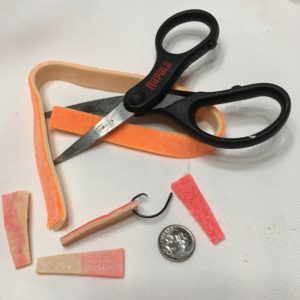
Probably one of the greatest reasons Fishbites are so effective is that they are very resistant to being torn off the hook. Because of that thin, white mesh buried inside, they are extremely strong and nearly impossible for a fish to steal without getting hooked. Additionally, because they are so tough, you won’t ever sling them off during the cast. The same cannot be said of many of the other bait options.
Over time, Fishbites will completely dissolve off your hook, so you will have to periodically change baits by ripping or cutting the spent white mesh off of your hook and putting on a fresh bait. I like to use a cheap pair of Rapala scissors (shown above) for this task. I’m bad about misplacing them so I usually have more than one pair. I also use these to cut my braided line and various dead baits. Here is a link to the Rapala Super Line Scissors on Amazon. They get great ratings and I can back that up. I’m sure there are other great options, but these are always available in my local sporting goods department and they are cheap, small, lightweight and just work great.
To hook Fishbites, simply run a small 1/0 circle hook through one end ONCE so as to not overfill the hook. Trust me, it’s going to stay on there just fine and I have not noticed a significant lack of bites due to the hook’s visibility.
** QUICK TIP **
When storing your Fish Bites between fishing trips, don’t leave them in a hot environment like a garage in the Southeast USA. I have had packages completely melt into a goo after sitting in my hot garage for many months. So, if it’s going to be a while before you use them again, store them inside your home. Better yet, put them in the refrigerator to maintain maximum freshness.
Banana-Shaped (Goofy) Jigs
For the sake of discussion all of these are included here as “Banana-shaped jigs” – Doc’s Goofy Jigs, Silly Willy Jigs, Buccaneer Wiggler Jigs, among others.
All the jigs listed above pretty much work the same so I’m grouping them together. I believe Doc’s Goofy Jigs were the first and they originated out of Tampa Bay, Florida. They are probably the most “famous” of these types of jigs in Florida.
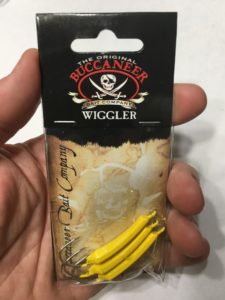
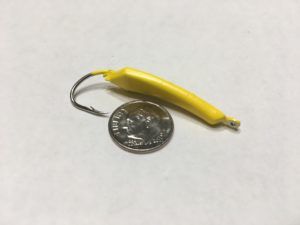
The best colors are yellow, chartreuse, white, yellow/white, orange or pink. Pink and Orange are great choices in dingier water. You will need to experiment with colors to find what works best for your location and the particular day.
Banana style jigs excel at covering a lot of water when you want to make long casts. When slowly retrieved, they scurry along the bottom with the hook facing up. You want to try to imitate a crab or shrimp bumping along the bottom. To do this, retrieve them slowly while occasionally giving your rod tip some sharp twitches. You want to make the lure slightly bounce off the bottom to create small clouds of sand much like a fleeing crab would make. You are likely to also catch whiting and other bridge and surf-dwelling species with this lure.
Braided line combined with a very fast action rod will make it easier to get the action from the lure you want when you are twitching it. If you do use braid, be sure to tie on a mono or flourocarbon leader as pompano have great eyesight.
It’s a good idea to use a teaser with these jigs as many times that is what you will actually hook the fish on. Yellow or Pink is a good color for a teaser. Just attach them using a split ring while facing the hooks in opposite directions, or for better action tie them together using a loop knot of 2 or 3 inches. Doing so lets the teaser have more action and in theory triggers more strikes.
It should be noted that these don’t just catch pompano, but many other fish will also hit them such as permit, flounder, spanish mackerel, mangrove snapper, snook among others.
As with most baits you will need to match the weight with the conditions. You could go all the way down to ¼ ounce in the calm waters on gulf beaches but may have to move all the way up to ½ ounce in deeper water or where there is more current. Good all-around sizes are 3/8 or 1/2 ounce.
Nylure Pompano Jigs
Bomber Saltwater Nylure jigs are old-school, tried and true pompano jigs that work great today. The nylon skirts have a fish-attracting shimmer and action that just flat out produces. They come in packages of 3 and they have a 2/0 sized hook which is perfect.
Below are Amazon links to the two styles available for this jig. You can also pick these up at Dick’s Sporting Goods, Ebay and many local bait and tackle shops. White, Pink and Chartreuse are all good colors for pomps.
These jigs work well around bridge pilings as well as in the surf. For added attraction, tip them with a small piece of shrimp, Fishbites or sand flea. I think the ½ ounce variety works better for the surf.
Slowly work them along the bottom while occasionally twitching them to get them to hop up a little so as to create that fish-attracting sand cloud on the bottom.
Bucktail Jigs
Bucktail jigs are one of those classic surf fishing baits that still work well, and will always work well. A 1/4 to 1/2 ounce white bucktail jig is a good option. Similar to Nylure jigs, tip these with a small piece of shrimp or a tiny sand flea and work it just the same. You can definitely expect to pick up other species with this lure while fishing for pompano.
Soft Plastics
There are lots of great soft plastic options for pompano. The ever popular D.O.A. shrimp in the smaller sizes will work as well as a Gulp shrimp cut in half like pictured below. That’s just a couple of examples of the seemingly endless options you would have with soft plastics, if you chose to go that route.
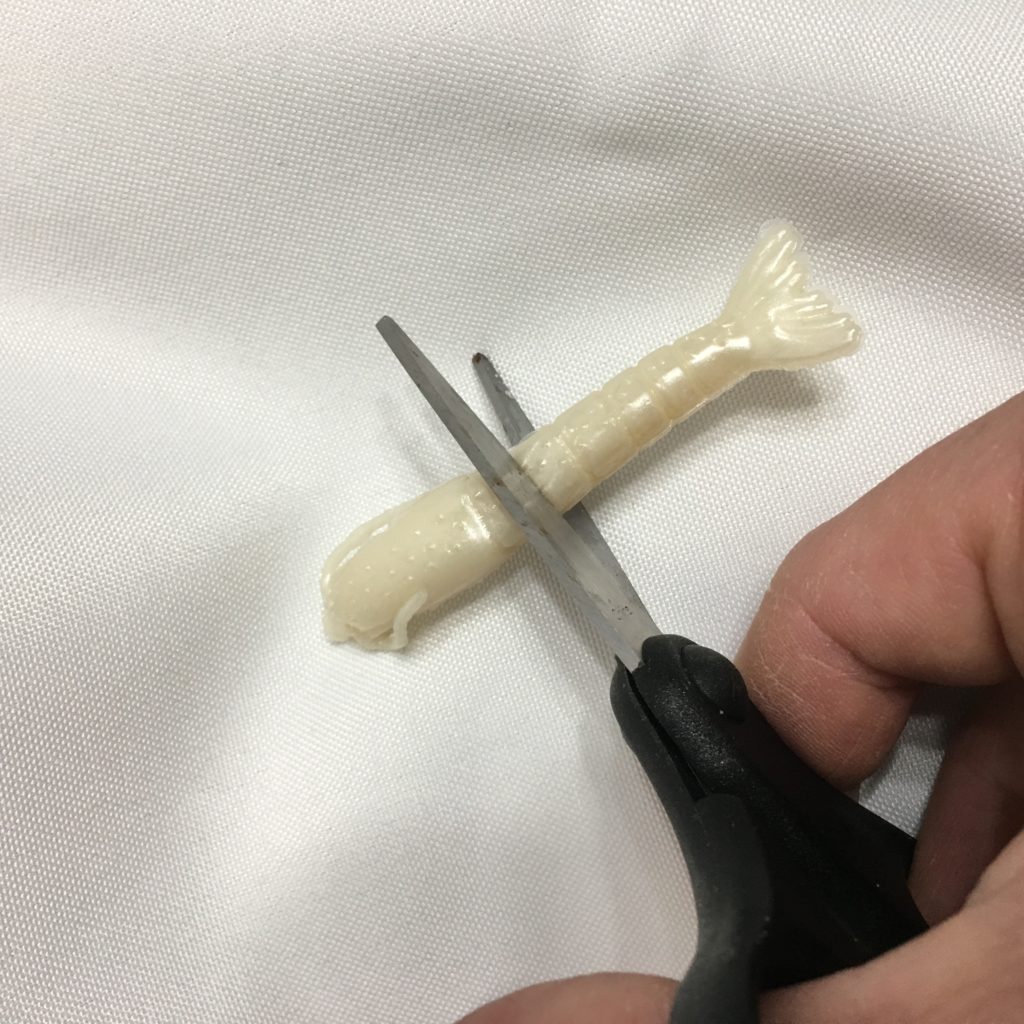

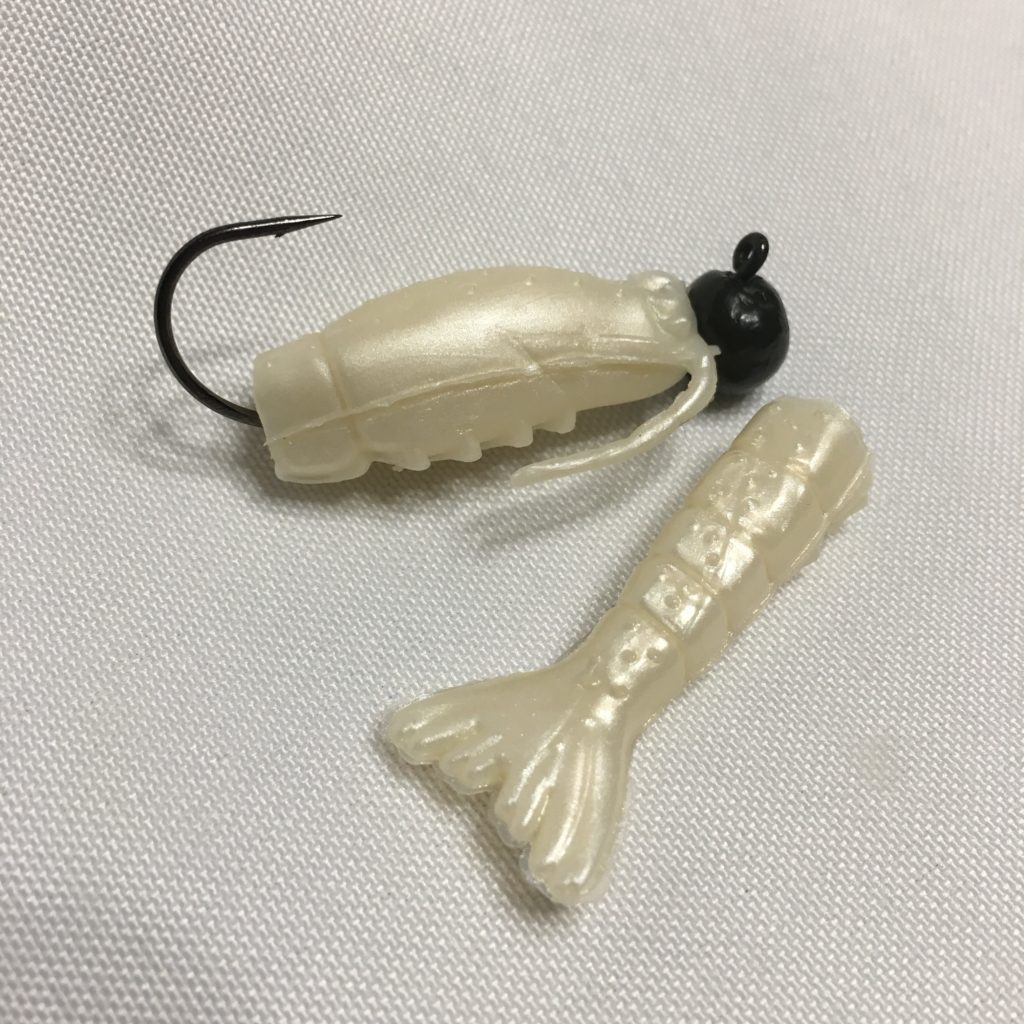
Crappie Jigs
Believe it or not, crappie jigs work well for pompano. They wouldn’t be a top choice of mine, but if you already have some on hand, there is nothing wrong with using them. I would use the larger ones with a bigger hook and not the tiny 1/16 ounce thin-wire jigs. Any of the normal colors that work well for pompano should be fine,, such as white, yellow, chartreuse, pink or orange.

Conclusion
My personal preference for Pompano is to take to the beach with me some fresh dead shrimp, a couple packs of fish bites in pink and orange and my sand flea rake. I’ll initially cast out shrimp and fish bites on 2-hook pompano rigs and then turn my attention to locating sand fleas out in front of my setup. If I can’t find any sand fleas on a given day, then I might run out of shrimp at some point. But, that’s OK because Fish Bites work great. I have even gone to the beach with nothing but Fish Bites and caught a limit of Pompano with no problem. As an aside, I have never actually used clams as bait, but I’m thinking I might have to give those a try during a future outing since pompano love those coquina clams so much.
Any one of the baits discussed above should be able to entice a hungry pompano for you when they are running the beach in your area.
I wish you luck on your next fishing trip!
Augustus Clay
